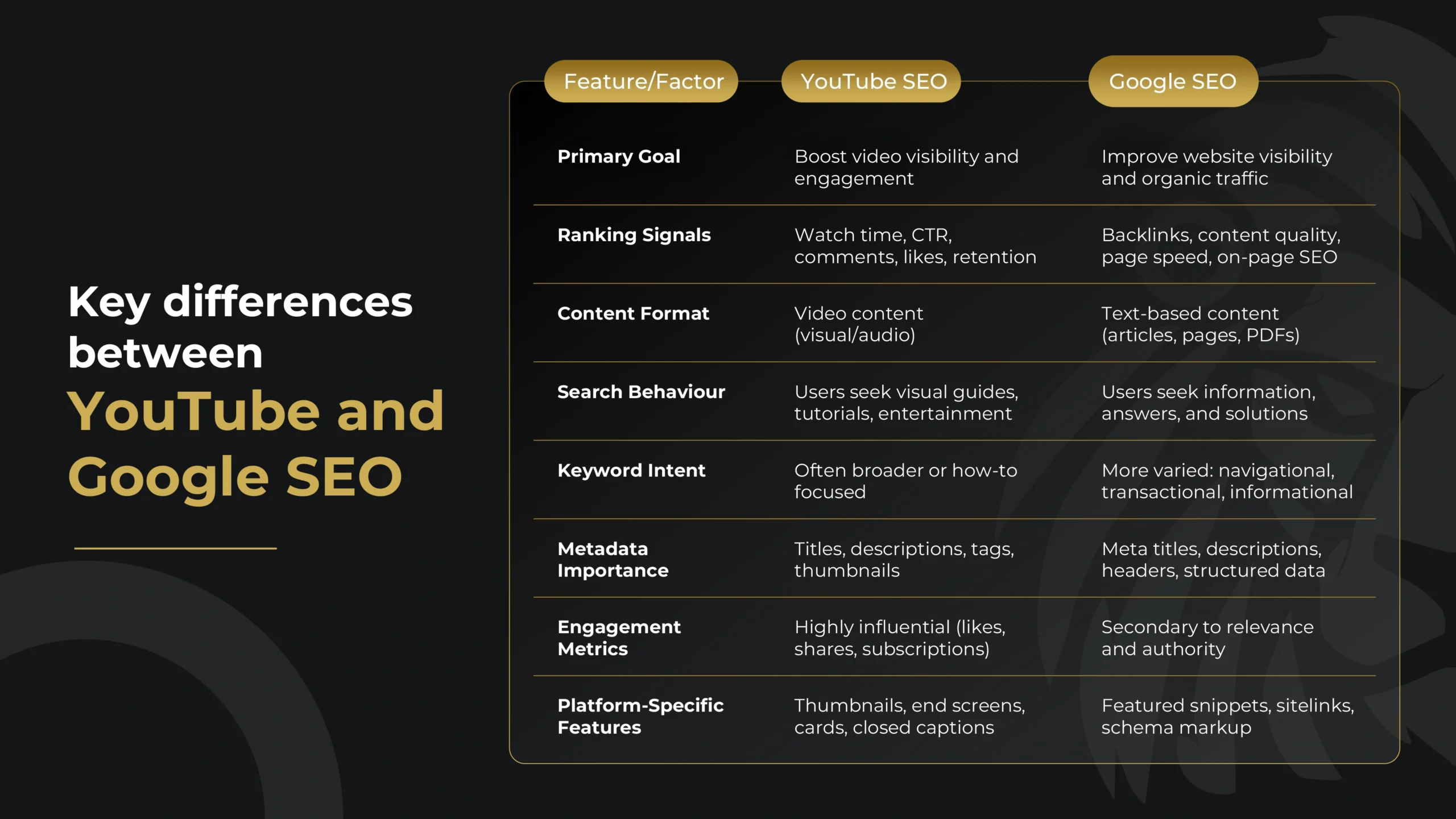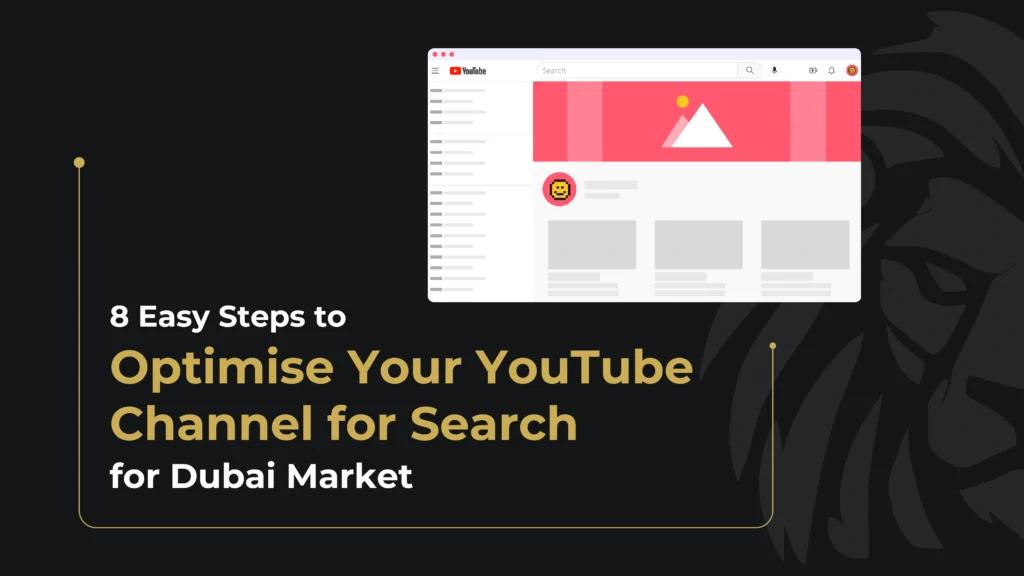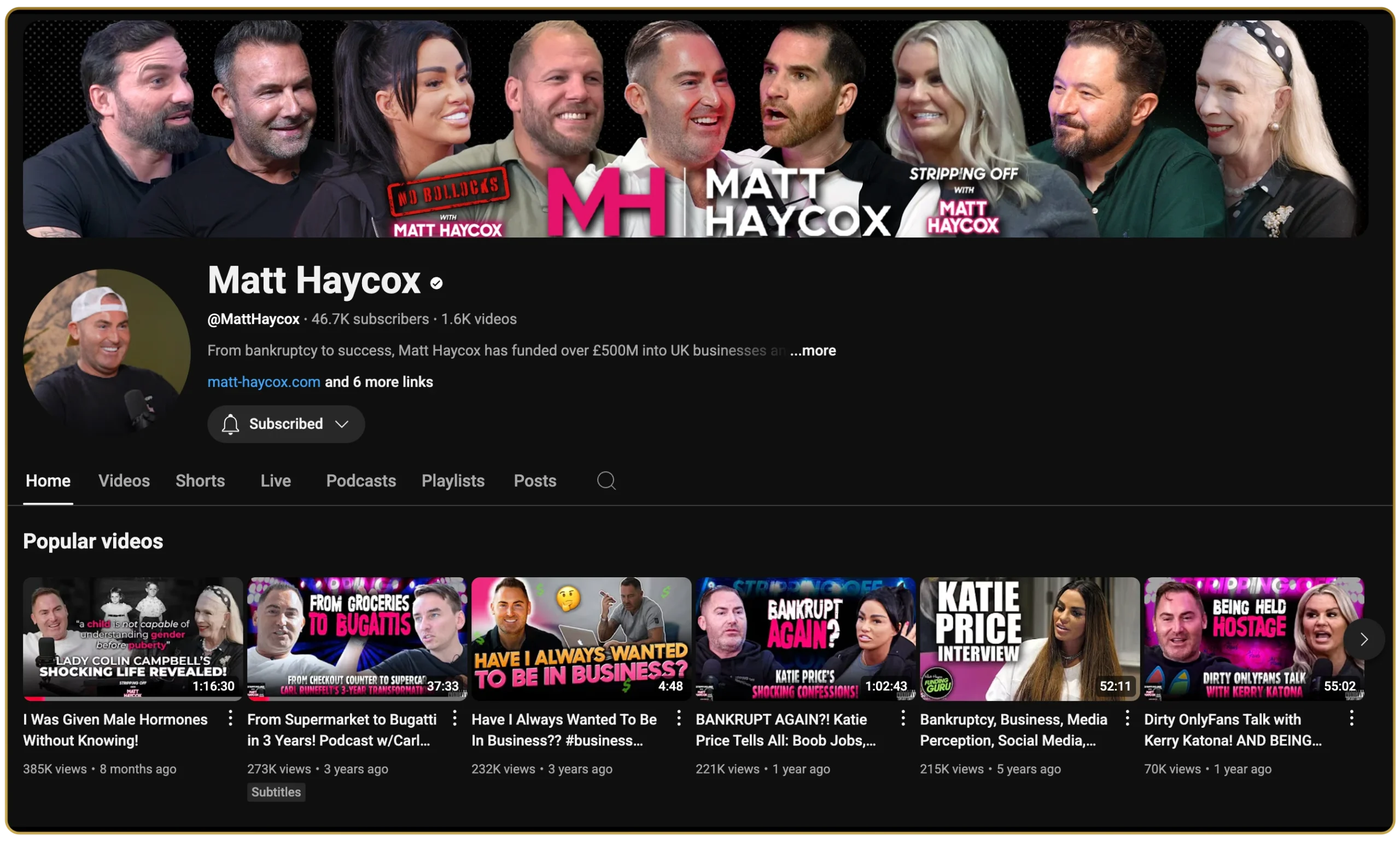With over 2 billion monthly users, YouTube is the second-largest search engine globally, making it a powerful platform to grow your brand, attract leads, and boost visibility. But simply uploading videos isn’t enough. To truly stand out, you need to understand what YouTube SEO is, how it works, and how to implement it strategically.
Whether you’re a business owner, content creator, or marketer, learning how to optimise your YouTube channel will make a measurable impact. In this guide, we’ll break down SEO for YouTube into seven easy, actionable steps covering everything from keyword research to channel optimisation.
We, as Dominate Online, prepared eight critical steps to optimise your YouTube channel and outrank your competitors. Let’s dive deep, each.
10 Key Takeaways: YouTube SEO Optimisation Tips
- Use clear, keyword-rich titles that match what people are searching for.
- Write detailed video descriptions with important keywords early on.
- Group your videos into playlists to keep viewers watching more.
- Design custom thumbnails with bold text and high-contrast visuals.
- Add closed captions in both English and Arabic to reach more people.
- Use tools like TubeBuddy or vidIQ to find the best keywords and tags.
- Track key metrics like watch time, click-through rate, and audience retention.
- Regularly check your analytics to spot what’s working and what’s not.
- Use end screens and cards to promote other videos or get more subscribers.
- Keep your channel branding consistent and your layout easy to navigate.
How the YouTube Algorithm Works (in Simple Terms)
To grow your channel, you need to understand what YouTube’s algorithm looks for when recommending content. Here’s a quick breakdown:
-
Watch Time
The total time people spend watching your videos (longer is better). -
Click-Through Rate (CTR)
How often people click your video after seeing the title and thumbnail. -
Audience Retention
The percentage of a video people watch—videos that hold attention rank better. -
Engagement
Likes, comments, shares, and subscribers all signal quality and relevance. -
Video Consistency
Posting regularly helps the algorithm recognise your channel as active and reliable. -
Relevance & Metadata
Titles, tags, descriptions, and transcripts help YouTube understand your content and match it with the right audience. -
User History & Behaviour
YouTube recommends videos based on each viewer’s past watch behaviour and interests.
Understanding these signals as we do for Google Algorithm changes allows you to align your content with what YouTube wants, making it easier to rank and be discovered organically.
Understand the Basics of YouTube SEO
What is YouTube SEO?
YouTube SEO refers to the process of optimising your videos and channel to rank higher in YouTube’s search results. It involves strategic use of titles, descriptions, keywords, tags, and engagement signals to improve visibility and discoverability. Just like Google, YouTube relies on an algorithm that ranks content based on relevance, quality, and user behaviour.
For businesses and creators in the UAE, where digital consumption is rapidly growing and bilingual content (Arabic & English) is the norm, mastering SEO for YouTube offers a unique edge. With the right optimisation, your videos can reach both local and regional audiences actively searching for content. Understanding what YouTube SEO is helps you stay ahead in a competitive digital market and turn viewers into loyal customers.
Key differences between YouTube and Google SEO
While both YouTube and Google rely on algorithms to rank content, their signals and priorities differ significantly. Google SEO focuses heavily on backlinks, domain authority, and structured content, whereas YouTube SEO prioritises user engagement such as watch time, click-through rate (CTR), likes, comments, and video retention.
Another key difference is keyword intent: people use Google for quick answers, while YouTube users seek visual, in-depth content. Additionally, YouTube offers unique optimisation elements like thumbnails, closed captions, and video metadata. Understanding these differences helps UAE businesses tailor strategies to dominate both search engines effectively.

How effective YouTube SEO drives visibility and subscriber growth
Implementing strong YouTube optimisation methods helps your videos appear in search results and suggested feeds, increasing visibility. Optimised content attracts more clicks, longer watch time, and higher engagement—all signals YouTube rewards with better rankings. Over time, this leads to consistent subscriber growth and stronger brand authority in the UAE market.

Conduct Effective Keyword Research for Your Videos
Step-by-step guide to finding relevant, high-volume keywords
Finding the right YouTube SEO keywords starts with understanding your audience’s search intent, the same as Google SEO keyword research. Begin by typing seed phrases into YouTube’s search bar to see autocomplete suggestions. Then, use tools like TubeBuddy, VidIQ, or Google Trends to validate search volume and competition. Look for long-tail keywords that reflect specific queries, such as “how to start a vlog in Dubai.” Analyse competitors’ top-performing videos for additional ideas. Finally, shortlist keywords that balance relevance, search volume, and low-to-medium difficulty. This keyword research process ensures your videos are discoverable and aligned with what UAE audiences are actively searching for.
Recommended Tools: TubeBuddy, Ahrefs, and Google Trends
A powerful browser extension designed specifically for YouTube creators.
- Pros:
- Real-time keyword score and search volume
- Optimisation checklist and thumbnail generator
- Competitor video analysis
- Cons:
- Full features are behind a paywall
- Slight learning curve for beginners
A robust SEO tool with a dedicated feature for YouTube keyword analysis.
- Pros:
- Accurate keyword volume and difficulty
- Comprehensive data for both YouTube and Google
- Strong competitor research capabilities
- Cons:
- Premium pricing
- Interface is more tailored to experienced SEO users
The tool is free for identifying trending topics and comparing keyword popularity over time.
- Pros:
- Ideal for spotting real-time search trends in the UAE
- Allows comparison between search terms
- Completely free
- Cons:
- No exact keyword volume metrics
Requires manual interpretation of data.
These tools are essential for building a smart, localised YouTube SEO strategy—especially when targeting bilingual audiences across the UAE.
How to leverage competitor analysis to discover hidden keyword opportunities
Search for top-performing videos in your niche and analyse their titles, tags, and descriptions using tools like TubeBuddy or VidIQ. Identify keywords they consistently rank for but don’t explicitly target. These overlooked terms can help you uncover YouTube SEO opportunities your competitors haven’t fully optimised for.

Optimise Your Video Titles, Descriptions, and Tags
Optimise Your Video Titles, Descriptions, and Tags
Crafting strong metadata is a core part of every effective YouTube SEO checklist. Follow these actionable tips to boost your video’s discoverability:
- Write keyword-rich titles
Begin with your target keyword and keep titles under 60 characters. Use clear, benefit-driven language to encourage clicks. - Use numbers or brackets
Titles with formats like “5 Tips for…” or “[2025 Guide]” tend to attract higher click-through rates. - Craft detailed descriptions
Aim for at least 250–300 words. Include your primary keyword in the first 100 characters, and naturally use secondary terms throughout. - Add timestamps
Break long videos into chapters for better user experience and potential SERP features. - Include strong CTAs
Guide viewers to subscribe, like, or visit your website. - Apply relevant tags
Use a mix of exact-match, broad, and branded tags to help YouTube understand your content context. - Avoid keyword stuffing
Repeating keywords unnaturally can harm rankings—stick to clean, concise metadata.
These YouTube SEO tips will strengthen your content’s relevance and make it easier for both the algorithm and users to find your videos.

Boost Engagement with Compelling Thumbnails and Captions
A well-optimised video needs more than just a good title, visual appeal and accessibility also matter. Thumbnails and captions directly influence click-through rates (CTR) and viewer retention, two key YouTube SEO factors.
Thumbnail Optimisation Tips:
- Use bold, high-contrast colours to catch the eye on both desktop and mobile.
- Include text overlays (3–5 words) that reflect the video title or hook.
- Use close-up faces and expressive emotions—this human element improves CTR significantly.
- Keep branding consistent across all thumbnails to build visual recognition.
- Test variations using A/B tools like TubeBuddy’s “Click Magnet” to see what works best.
Caption and Subtitle Strategy:
- Always upload closed captions; they improve accessibility and allow viewers to follow along without sound.
- Include both Arabic and English captions to cater to the UAE’s bilingual audience.
- Use accurate timing and punctuation to enhance readability and viewer trust.
- Consider adding transcript text to the video description for SEO value.
By combining visually strong thumbnails with multilingual captions, your videos will become more accessible, engaging, and algorithm-friendly—boosting both your visibility and subscriber growth.

Enhance Channel Structure with Playlists and Branding
A well-organised YouTube channel not only improves user experience but also sends strong SEO signals to YouTube. Structuring your content strategically helps retain viewers and encourages binge-watching.
Smart Playlist Strategy:
- Organise videos into topic-based playlists to guide users through related content.
- Use keyword-optimised playlist titles and descriptions to boost search visibility.
- Feature playlists on your channel homepage for easy navigation.
Professional Branding Tips:
- Maintain consistent banners, logos, and thumbnails for a recognisable visual identity.
- Optimise your profile image and channel description with relevant keywords.
- Use a branded channel trailer to introduce new visitors to your content and value.
Engagement Boost with End Screens & Cards:
- Add end screens to promote other videos, playlists, or subscription links.
- Use video cards to suggest related content during playback and increase session duration.
A polished, well-structured channel makes your content more discoverable—and keeps viewers coming back.

Leverage YouTube SEO Tools to Streamline Your Workflow
Mastering YouTube SEO tools is essential for running an efficient and data-driven video strategy. The right tools help you uncover keyword opportunities, optimise metadata, and track performance with precision.
Recommended SEO Tools:
- TubeBuddy: Offers browser-based features like keyword explorer, tag suggestions, and A/B thumbnail testing.
- vidIQ: Great for tracking competitors, trending videos, and engagement analytics.
- Ahrefs YouTube Keyword Tool: Ideal for detailed keyword research and content gap analysis.
When to Upgrade:
Free versions are useful, but premium plans unlock advanced features like bulk processing, click-through benchmarks, and competitor tracking—valuable for serious content creators or agencies.
Using Analytics Effectively:
Monitor metrics like watch time, average view duration, and traffic sources via YouTube Studio. These insights help you refine content strategy, identify what works, and justify SEO decisions.
By integrating these tools into your content workflow, you’ll save time, improve ranking accuracy, and grow your channel with data-backed decisions.

Monitor, Analyse, and Refine Your SEO Strategy
Successful YouTube SEO doesn’t end after publishing—it’s an ongoing process of tracking performance and making smart adjustments based on data. Here’s how to keep your optimisation sharp:
Key YouTube Metrics to Track:
- Watch Time: Total minutes people spend watching your video. Higher watch time signals value to YouTube’s algorithm.
- CTR (Click-Through Rate): The percentage of people who click after seeing your thumbnail/title. Low CTR? Tweak your visuals or titles.
- Audience Retention: Tracks how long viewers stay before dropping off. Aim to maintain engagement past the first 30 seconds.
- Engagement (Likes, Comments, Shares): Indicates content quality and relevance.
- Traffic Sources: Shows where viewers are discovering your videos—Search, Suggested, External, etc.
Recommended Tools:
- YouTube Studio: The native dashboard for tracking all major SEO metrics in real time.
- TubeBuddy: Offers retention graphs, click performance, and SEO audits.
- vidIQ: Provides advanced CTR heatmaps, SEO scorecards, and subscriber velocity tracking.
Regularly reviewing these insights helps you spot underperforming content, identify growth opportunities, and adjust your strategy to continuously improve rankings and subscriber growth.

Amplify Your YouTube Reach with Social Media Promotion
Social media platforms offer an ideal way to drive more traffic to your YouTube videos, especially in the UAE, where Instagram, TikTok, LinkedIn, and WhatsApp are widely used. Here’s how to make the most of them:
Cross-Promotion Tips:
- Instagram & TikTok: Share short teaser clips with captions and a link in bio. Use trending audio and local hashtags like #DubaiVlog or #UAEbusiness.
- LinkedIn: Post value-driven videos (like tutorials and thought leadership) to engage a professional audience. Always include a CTA to your YouTube channel.
- Facebook & WhatsApp: Share full videos or links in relevant community groups, especially if your content is local or niche.
- Twitter/X: Create short threads with key takeaways from your video and link to the full version.
Bonus Tips:
- Tag relevant accounts and collaborators for resharing.
- Use consistent thumbnails and hashtags to reinforce branding.
- Post at times when your audience is most active (use analytics!).
Social media isn’t just about more views—it’s about building a loyal cross-platform audience that drives long-term YouTube growth.

Ready to Dominate YouTube Search Results?
Your YouTube success depends on powerful SEO strategies. At Dominate Online, we specialise in advanced results-driven SEO techniques tailored for the UAE market—combining YouTube best practices with multilingual optimisation and regional insights.


